
More New Yorkers Are Struggling to Afford Public Transit: Report
Transportation and anti-poverty advocates are pushing the Adams administration to provide an extra $55 million in the next budget to expand the Fair Fares program—through which low-income New Yorkers can qualify for half-priced MetroCards—to include people earning up to 200 percent of the federal poverty level, or about $60,000 for a four-person household.
Marc A. Hermann / MTA
Subway riders entering the system at the Roosevelt Avenue-Jackson Heights station on Wednesday, Jul 26, 2023.
Last year, nearly one in five New Yorkers said they struggled to afford subway or bus costs, according to the results of a survey released Thursday—what transit and anti-poverty advocates say underscores the city’s need to expand its discount fares program.
Nonprofit Community Service Society (a City Limits’ funder) saw 19 percent of respondents to its 2023 “Unheard Third” survey report hardships in covering their transit costs, up from 14 percent in the same survey in 2021 and 18 percent in 2022. The survey, conducted by phone, canvassed 1,113 low- income residents and 645 moderate and higher-income residents across the city.
More moderate- and high-income residents last year—21 and 10 percent, respectively—said they also struggled to afford the subway or bus, greater than in previous years, the report found. The survey was conducted before the MTA’s latest fare increase in August 2023, when the cost of a ride went from $2.75 to $2.90.
“We are expecting to see even higher rates of transit hardship” this year, said Debipriya Chatterjee, a senior economist with the Community Service Society (CSS). She attributed the increased difficulties in 2023 to a number of factors: the drying up of pandemic-era aid and benefits, inflation and rising living costs, and more New Yorkers returning to in-person work that requires commuting.
CSS and other advocates are pressing the city to expand its Fair Fares program, which offers half-priced MetroCards for low-income New Yorkers. Last year, the city invested an additional $20 million to expand eligibility for the discount, which is open to applicants who earn at or below 120 percent of the federal poverty level (up to $37,440 a year for a family of four, or $18,072 for individual).
But that still locks out a swath of residents who struggle to pay for transit, advocates say, including minimum-wage earners. CSS estimates it would cost the city an additional $55 million, on top of the program’s current baseline budget of $95 million a year, to include residents earning up to 200 percent of the federal poverty level ($62,400 a year for a four-person household, or $30,120 a year for one person).
In her State of the City address this week, City Council Speaker Adrienne Adams included that among her budget priorities this year. “Better access to Fair Fares is needed to ensure it reaches New Yorkers who need support,” she said, “so that more people can access our public transit system to unlock opportunity.”
Reached for comment, City Hall did not directly address the calls to expand the program but provided a statement from Mayor Eric Adams. “We look forward to digging into the speaker’s proposals and continuing to build on two years of collaboration with her and the City Council to deliver on our shared goals,” he said.
State lawmakers also support a Fair Fares expansion: in budget proposals released this week, the Assembly called for adding $127.5 million to Albany’s next spending plan—due April 1—to extend eligibility to those earning 200 percent of the federal poverty level; the Senate proposed expanding the discounts to rides on commuter rail lines within the city.
Inability to afford subway and bus fare can have broader consequences for residents than just a missed ride.
“What we saw was folks saying that they have missed showing up for education and training, job interviews, medical appointments,” said Chatterjee. “And needless to say, any and all recreational meetings, like with family or friends or to museums—basically, what you would expect with restricted mobility.”
Transit costs hit certain populations harder than others, CSS’s survey found. More than a third of low-income working mothers who took part in the questionnaire reported struggling to pay for fares, while 37 percent of low-income Latino respondents did, higher than their Black, Asian or white counterparts.
In addition to expanding elgibility, CSS calls for the city to do more to spread awareness of Fair Fares. While participation nearly doubled between 2020 and 2023, and includes about 320,000 people currently, that’s still a only a fraction of those eligible.
The mayor’s office said it will continue to build on its outreach efforts: via social media campaigns to reach specific zip codes, trainings with community groups to help spread the word about eligibility and by sharing information with food pantries and houses of worship, a spokesperson said.
To reach the reporter behind this story, contact Jeanmarie@citylimits.org
Want to republish this story? Find City Limits’ reprint policy here.
The post More New Yorkers Are Struggling to Afford Public Transit: Report appeared first on City Limits.

